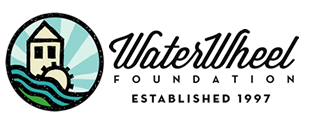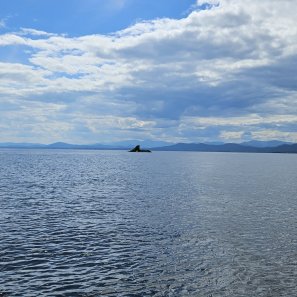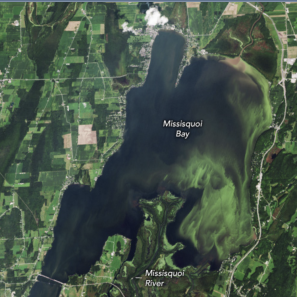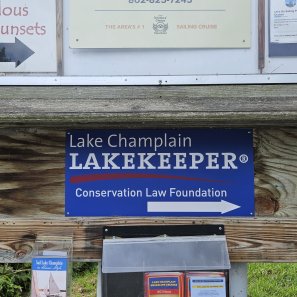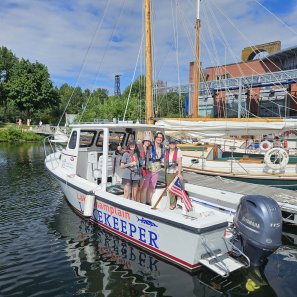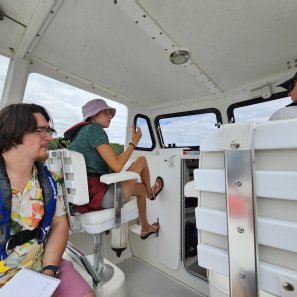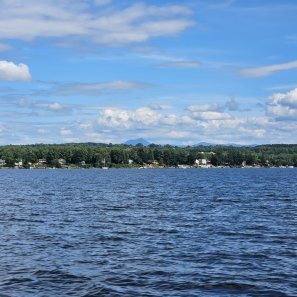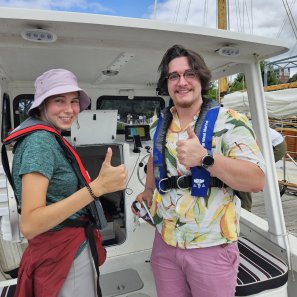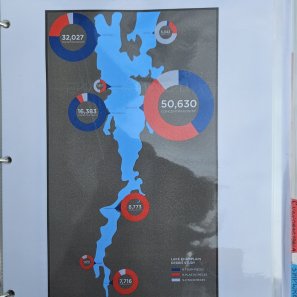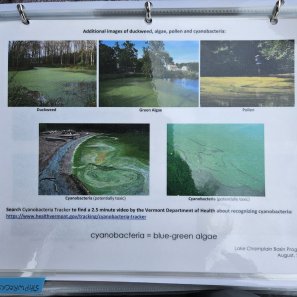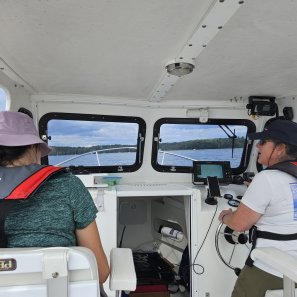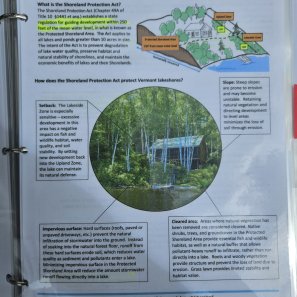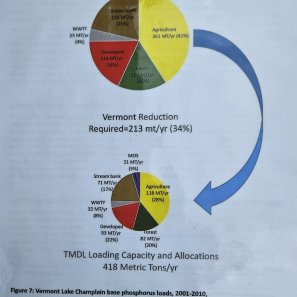WaterWheel interns spend a day with the Lakekeeper
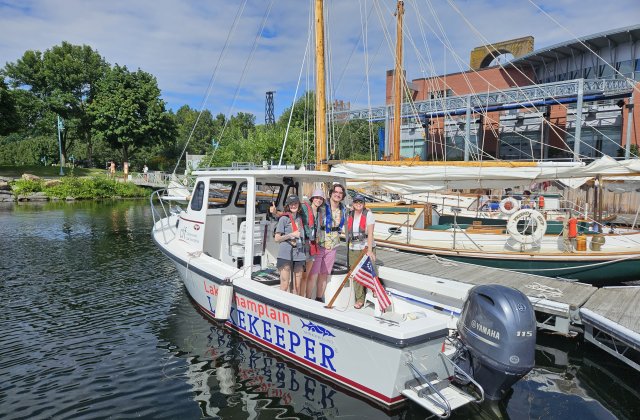
A Day with the Lakekeeper
Written by Cassidy Desantis and Cole Hathaway
Photos by Rileigh Hardy
The WaterWheel Foundation interns Cassidy, Cole, and Rileigh recently spent a day with Julie Silverman, the Lake Champlain Lakekeeper, to learn more about Lake Champlain and her role as its advocate. Thanks to the generosity of the Phish fan community, WaterWheel is proud to support the Lakekeeper’s important work.
We recently had a unique and fantastic opportunity to head out on the open water of Lake Champlain with the self-proclaimed “Lorax of the Lake,” The Conservation Law Foundation’s (CLF) Lake Champlain Lakekeeper, Julie Silverman.
One of Vermont’s most precious natural resources which was briefly designated as the 6th Great Lake in 1998, Lake Champlain is 120 miles long, and its deepest point is 400 feet. It is home to 56 different species of mammals, 93 species of fish, and over 300 species of birds. It provides fresh drinking water to over 200,000 people who live on or around it and also serves as a recreational hotspot for residents and tourists alike.
As the Lakekeeper, Julie is the eyes, ears, voice, heart, and soul of Lake Champlain. She collects samples of all kinds for scientific data to track patterns and the overall trajectory of the Lake’s health and then documents these findings via the CLF blog. On her Instagram, @lakekeeperjulie, she reports on pressing matters regarding the Lake and she also devotes her time to focusing more attention on restoration and protection efforts by speaking to legislators and with businesses and neighbors.
As the WaterWheel team explored the Lake with Julie, we talked with her about the Lake, the problems it is currently facing, and what we can do to help.
Julie has officially been the Lakekeeper for just over a year and a half, but after spending time talking with her, we could tell that her passion for keeping the Lake safe didn’t begin when she got the job. “I’ve been ‘lowercase a’ advocating for the Lake for years, but now I’m finally an ‘uppercase A Advocate,’” she said with a laugh as she took us around the famous Thrust Fault on her boat, aptly named Lakekeeper. For those who don’t know what that is: The Champlain Thrust Fault is part of a 200-mile-long fault that extends from Southern Quebec down to the Hudson Valley.
This section is unique because it is an example where older rocks are pushed above younger rocks and “thrust” to the surface, creating a fascinating geological sight that has been a point of study for geologists worldwide. It has an exposed section near the popular swimming area known as Lone Rock Point.
Because Julie firmly believes that it is important to preserve the Lake’s history and culture to not forget about the past when faced with the problems of the present, so she began the voyage by telling us about the history of the Lake. We learned the original Abenaki name, Bitawbakw, which means “the waters between.” The Abenaki are one of the Indigenous Peoples of the Northeastern Woodlands of Canada and the United States. The Missisquoi Abenaki (also known as the Sokoki, or “People of the Flint”) live in the Missisquoi Valley around Lake Champlain up to the headwaters. She also took us to see Odzhihozo, “the one who shaped himself” and told us his story. He is considered to be the mythical creator of Lake Champlain, as well as many other landforms around New England. According to legend, the rock formation in the Lake is where he chose to store his spirit and body after returning from his journey down the eastern coast to Connecticut. Folks living around the Lake today may know him by his colonial name (“Rock Dunder”) but Julie insisted on making sure that the proper respect is given to the Abenaki culture.
As we continued the tour, Julie showed us examples of polystyrene dock foam (Styrofoam) she found floating in the Lake and on the beaches, one of the plastic pollution issues currently facing Lake Champlain. This foam, made of the same single-use plastic that is being banned on land through legislation like Act 69 of 2020 is still being used for floating docks on the Lake. When the foam breaks down and floats off, larger chunks leach chemicals into the water and smaller beads infiltrate the food chain by getting eaten by fish and wildlife. Julie told us about a bill that CLF is proposing, H.373, which would move to ban the use of uncovered expanded polystyrene dock foam in the waters of the state. This bill is just one example of how CLF works with local environmental advocacy organizations to promote better practices to protect the environment.
We also spoke with Julie about the runoff of toxic chemicals and excess nutrients from fertilizers and cow manure into the Lake, an already serious problem that was exacerbated by the devastating July floods. During the floods, the raging waters of the Winooski and Lamoille rivers washed tons of chemicals, debris such as tires and trash, and sediment directly into the Lake. A wastewater pipe under the Winooski River broke and dumped 10% of Burlington’s untreated sewage into Lake Champlain.
Julie told us how more than a year’s worth of phosphorus washed into the Lake in just one week during the flood. This excess phosphorus, combined with the high heat of July, was the perfect cocktail to create a bloom of cyanobacteria, also known as blue-green algae, which is detrimental to wildlife and can be potentially toxic to Lake goers and their pets.
The best way to prevent such levels of damage from happening again, Julie said, is to directly invest in the restoration, preservation, and protection of natural floodplains and wetlands. She pointed out that Act 64, The Vermont Clean Water Act, was a great first step in achieving this. Still, she says we must go further with better-mandated wetland protection programs, mindful land development, and diversified restorative farming techniques. “We’re going to keep having propane tanks, cars, hay bails floating down murky water like marshmallows in hot chocolate, if we don’t move to prevent these floods from happening again,” she said.
When we asked Julie how people living around the Lake can help protect the Lake, she said they can talk to their neighbors, attend community meetings, and reach out to their local leaders to share their concerns about what’s happening to the Lake. “We know what we need to do,” she said, “we just need the political will to do it.” Along with advocacy, Julie wants people to stay informed and educated about issues regarding the Lake to ensure the public’s safety and awareness.
Thank you, Julie, for allowing us this opportunity to learn and understand more about Lake Champlain, and for taking such good care of our beloved Lake!
Click on the images below to view larger.
- Lone Rock Point, pictured here, is a popular swimming area in the lake for tourists and locals alike.
- The Champlain Thrust Fault, where you can see how the older sandy Durham Dolostone rock got “thrust” above the younger grey Iberville Shale.
- Odzhihozo, in the waters of Lake Champlain close to Shelburne, VT.
- Different examples of dock foam all found in Lake Champlain by Julie.
- A puffball replica created by Julie of one strain of cyanobacteria that lives in Lake Champlain, called Anabaena (An-Uh-Bean-Uh).
- A cyanobacteria bloom in Missisquoi Bay on September 1st, captured by the Operational Land Imager (OLI) on Earth Observation satellite Landsat 8.
- A helpful sign guiding folks to where Julie docks at the waterfront marina.
- Rileigh, Cassidy and Cole with Lakekeeper Julie!
- Cole and Cassidy learning from Julie.
- Lakeside real estate.
- Thumbs up!
- An infographic compiling data from a 2013 study by the Rozalia Project that documented marine debris levels in shoreline sediment on Lake Champlain.
- Cole admiring the view from the Lake.
- Different examples of what cyanobacteria can look like from Julie’s Lake information binder.
- One example of the over 300 species of birds who live on the Lake.
- “Pebbles” of dock foam, which are easily consumed by fish in the lake or just left to leach toxins into the water.
- View of Burlington from the Lake.
- Cassidy and Julie up front in “Lakekeeper”
- A summary of the Shoreland Protection Act, an effort to guide development within 250 feet of the mean water level (called the Protected Shoreland Area) which went into effect on July 1, 2014.
- Two pie charts. The top shows the base load of phosphorus recorded in the Lake from 2001-2010 and the bottom chart shows the 34% decrease required by the EPA. (TMDL=Total Maximum Daily Load).
